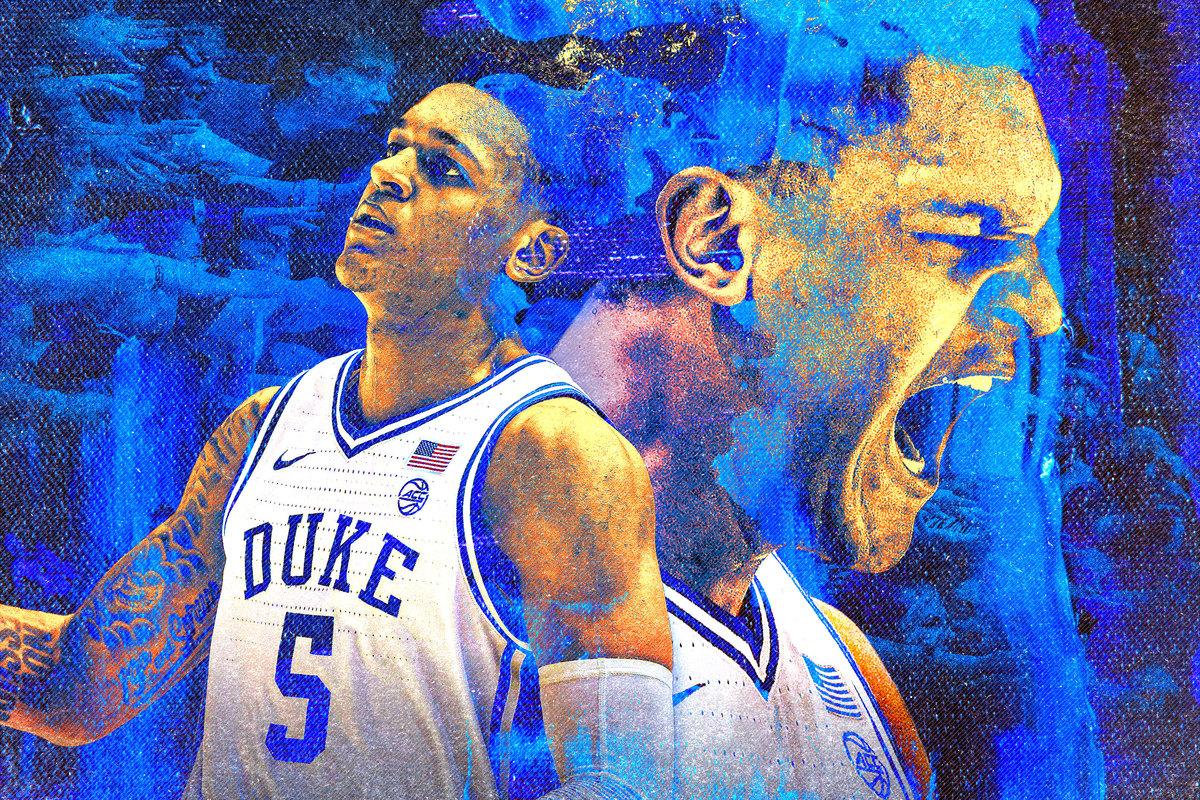
Duke opened its season against Kentucky at Madison Square Garden. It was a who’s who of current NBA players, coaches, and front office personnel in the stands. But all eyes were on Duke freshman Paolo Banchero, one of the front-runners to be the top pick in the 2022 NBA draft.
The intrigue was obvious. Banchero was an 18-year-old (he turned 19 a few days later) listed at 6-foot-10 and 250 pounds. On the opening possession, he drove from the 3-point line to the rim. A few minutes later, he crossed up his defender and drained a pull-up jumper. Then he got a rebound, brought the ball up himself, and spun through traffic to draw a foul.
Paolo looked like an NBA All-Star who had been dropped into a college game against kids a decade younger. It wasn’t just that he was built like the Hulk. It was the poise that he played with. Never rushing. Not letting the defense bother him. He was perfectly in control at all times.
Duke has produced a lot of great NBA talent in the one-and-done era. Banchero is one of the few who instantly looked like he belonged at the NBA level. It was like Kyrie Irving in 2010, when he already had most of the same dribble and layup moves that he has now, and Zion Williamson in 2018, when he might as well have been playing a different sport than anyone else on the court.
Paolo hasn’t taken the college basketball world by storm in quite the same way as Zion, but he’s having an excellent season in his own right. Duke is right in the thick of the national title race with an 18-3 record and signature wins over Gonzaga and Kentucky. He’s the team’s leading scorer (17.8 points per game) and rebounder (8.3) while ranking third in steals (1.1) and fourth in assists (2.6).
The most impressive part of the teenager’s game is his efficiency. Paolo is shooting 49.6 percent from the field with a 57.3 true shooting percentage. None of the other Duke one-and-done wings who have been taken in the top three in the past decade—RJ Barrett, Jayson Tatum, Brandon Ingram, and Jabari Parker—marked that high. The key is how much better Paolo shoots from 2-point range:
Duke One-and-Done Wings
The difference is pretty obvious. He’s just a lot bigger than any of the players who came before him. That’s the elevator pitch for Paolo. What would happen if you put the polished offensive game of a guard into someone with the size of a center?
Paolo knows how to use his physical advantage, too. He’s a capable outside shooter (31.8 percent from 3 on 3.1 attempts per game) who shoots well enough from the free throw line (75 percent on five attempts per game) to suggest that he’ll be able to stretch the floor in the NBA. But settling for a jumper bails out the defense when a player is as big and strong as he is. Banchero is at his best when he puts his head down and goes to the rim. He has a lower 3-point rate (the percentage of his shots that come from behind the arc) than any of his predecessors but Parker.
His offensive dominance is somewhat masked by the talent around him. There are a lot of mouths to feed at Duke. Paolo starts next to another future lottery pick in freshman AJ Griffin as well as two more potential first-rounders in junior Wendell Moore and freshman Trevor Keels. Add another ball handler in sophomore point guard Jeremy Roach and it often feels like there are too many cooks in the kitchen. Paolo leads the Blue Devils in field goal attempts (13.1 per game), but Keels (10.6) and Moore (10.2) aren’t far behind him. Both also average more assists, an indication that they have the ball in their hands more often.
What Coach K is still trying to figure out is how Banchero can impact the game when he isn’t scoring. He tried smaller lineups with Paolo at the 5 earlier this season to spread out the defense and get all of his best offensive players on the floor. Though he manages a block per game, the freshman is a guard at heart. He doesn’t have the instincts of a rim protector and prefers to play on the perimeter rather than anchor the defense. Coach K ended that experiment after an upset loss to Miami in early January when the Hurricanes sliced the Blue Devils up with back cuts. The playing time for his two traditional centers—sophomore Mark Williams and senior Theo John—has trended up in conference play since.
Nor has Coach K used Banchero as a perimeter stopper. Moore, Keels, and Griffin have gotten the tougher assignments this season. Paolo is a good but not great athlete and he often seems to coast on that end of the floor. That’s common for big-time scorers early in their careers. Some grow out of it—some don’t.
The good news is that he’s unlikely to be a net negative on defense. Even if he never becomes a stopper, Banchero is so big and fast that he should always be able to handle one of the forwards on the opposing team. There’s also a benefit just from having someone with his physical tools on the wing because of how much it shrinks the floor. Any team that drafts him will have a huge frontcourt. I’ve heard NBA scouts compare his defense to Tobias Harris’s. He’s not the tip of the spear for the 76ers, but he has played big minutes for one of the top defenses in the league over the past few seasons.
Banchero’s value, at least early in his NBA career, will likely come from his offense. That brings us to his passing. He isn’t a black hole but he’s not picking apart defenses, either. He’s averaging 2.6 assists and 2.5 turnovers per game. Paolo doesn’t really make anyone better. He waits his turn to get buckets and expects everyone else to do the same. The most direct path for him to improve is to become better at setting up his teammates.
He has the ability to be a good playmaker. He’s so big that he can see over the defense and make the right passes when he gets double-teamed. He’s also such a good scorer that passing should be easier for him than it is for most players. He doesn’t have to make something out of nothing. His mere presence on the floor distorts the defense and creates openings for everyone around him. There’s no one in college basketball who can guard him one-on-one.
Banchero’s passing has improved during this season. He averaged 2.1 assists and 2.0 turnovers per game in their 11 nonconference games and 3.6 assists and 2.8 turnovers in their first nine ACC games. Handing out more assists doesn’t mean much if you are also turning the ball over more often. But the fact that Paolo’s assist-to-turnover ratio is increasing shows that he’s making better decisions with the ball.
The types of assists that he gets are crucial, too. He had a career-high seven dimes in an OT loss to Florida State on January 18. His last two came with just over a minute left in regulation, when he found Mark Williams for two clutch alley-oops. If Paolo doesn’t play center on defense, then he’ll have to find ways to play with a center on offense. It would be ideal if he were paired with a stretch 5, but those players are few and far between. Paolo isn’t a great 3-point shooter so he will likely have to make plays in tight spaces to score around the basket at the next level.
It mostly comes down to mindset. Banchero, like every great scorer, can create a good shot for himself anytime he wants. But just because he can doesn’t necessarily mean that he should. It goes beyond even making sure his teammates stay involved in the offense. Involving his teammates will also make it easier for him to score. If the defense knows that he will pick apart a double-team, they will be less likely to send help.
There’s obviously no way for us to read his mind to see what kind of player he will become. The best we can do is dive into his background and look at the careers of the players who have come before him. That’s where comparing his college production to those of previous Blue Devils is useful. But it tells us only so much.
Just because they all made a pit stop in Durham doesn’t mean they have that much in common. To understand Paolo, you have to know where he’s from. He’s from Seattle. His parents met at the University of Washington, where his dad played football and his mom was the all-time leading scorer on the women’s basketball team.
Seattle doesn’t get much publicity as a basketball hotbed, especially since the Sonics left in 2008, but it has produced a lot of high-quality NBA players over the last generation. Now see whether you can notice a pattern: Jamal Crawford. Zach LaVine. Isaiah Thomas. Nate Robinson. Jason Terry. Brandon Roy. It’s a city of bucket-getters. Paolo represents the evolution of that idea. It doesn’t matter how big you are if you are from Seattle. Even their big men can cross up defenders, put them in a blender, and rain jumpers.
But who was the best Seattle product? It wasn’t Crawford, it was Roy. He made three All-Star teams in his first four seasons in the NBA before his knees betrayed him. What separated the two silky scorers? Command of the game. Roy could also run the offense and set up his teammates in a way that Crawford couldn’t.
Playmaking could separate Paolo from Chet Holmgren and Jabari Smith Jr., the two other top players in this year’s draft. He’s the best scorer of the three so it should be easier for him to leverage that ability to make his teammates better. But if all he’s going to do is get buckets, then it puts a ceiling on his game.
There is no question that Paolo will be a great scorer in the NBA. That was clear from the moment his time at Duke began. His passing will determine how great a player he becomes.

